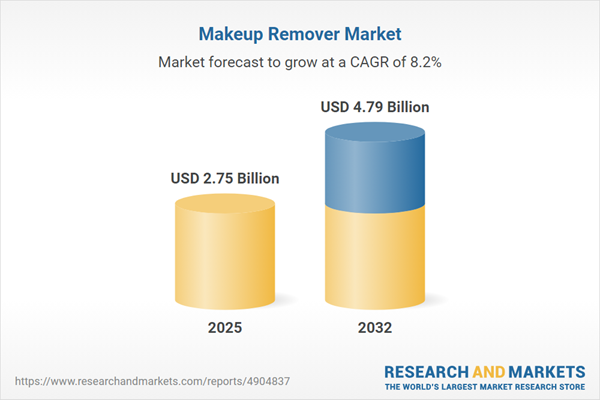Speak directly to the analyst to clarify any post sales queries you may have.
The makeup remover market is evolving as global brands address urgent sustainability goals, complex regulatory demands, and heightened consumer expectations. Senior decision-makers are navigating this transformation by leveraging high-impact intelligence and strategy to secure long-term relevance and growth.
Market Snapshot: Global Makeup Remover Market Size and Trends
The global makeup remover market currently stands at USD 2.54 billion, and forecasts predict growth to USD 2.75 billion by 2025 and USD 4.79 billion by 2032, signaling a compound annual growth rate of 8.24%.
This steady market expansion is propelled by visible shifts in consumer values toward ingredient transparency, ethical sourcing, and increased adoption of eco-friendly product innovation. Leading organizations are developing recyclable packaging, broadening product lines for cultural and regional preferences, and increasingly leveraging digital engagement to serve a diverse, technologically connected demographic. Staying in sync with these drivers is essential to maintain competitive agility and relevance within this fast-changing space.Scope & Segmentation: Strategic Insights for Makeup Remover Market Leaders
- Distribution Channels: Utilizing pharmacies, supermarkets, specialty retailers, e-commerce, and direct-to-consumer models provides brands with efficient access to established and emerging customer bases, supporting flexible go-to-market strategies.
- Ingredient Types: Expanding portfolios to include natural, organic, vegan, non-vegan, mineral oil, and surfactant-based formulations meets evolving consumer preferences and compliance requirements, while driving ongoing product innovation.
- End User Profiles: Strategic segmentation by age and gender enables more precise marketing and campaign design, heightening resonance with distinct consumer groups and promoting stronger engagement rates.
- Skin Types Addressed: Tailoring products for dry, oily, sensitive, combination, and normal skin aligns offerings with the growing demand for personalized skincare, allowing entry into specialized market subsegments.
- Product Forms: Offering wipes, creams, foams, micellar waters, and oils accommodates differing makeup removal routines, encouraging innovation to match changing user behaviors.
- Geographic Coverage: Market analysis spans the Americas, Europe, Middle East and Africa, as well as Asia-Pacific, assisting brands with region-specific compliance, distribution adjustments, and strategies reflecting local market dynamics.
- Company Profiles: Detailed benchmarking of leading entities—L’Oreal, Procter & Gamble, Unilever, Estée Lauder, Johnson & Johnson, Beiersdorf, Shiseido, Kao Corporation, LVMH, and e.l.f. Beauty—provides decision-makers with valuable peer context to inform partnership and competitive positioning decisions.
Key Takeaways for Senior Decision-Makers
- Accelerated product development focused on safety and ingredient clarity is essential to maintaining alignment with regulatory changes and strengthening brand trust among aware consumer groups.
- Pursuing digital innovation—including AI-enabled skin analysis and advanced online engagement capabilities—enables brands to deliver bespoke customer experiences and foster higher customer loyalty.
- Building agile supply chains prepares brands to manage and swiftly adapt to regulatory requirement shifts, while ensuring consistent product quality across global markets.
- Sharpened segmentation and targeted messaging on demographic and skin-type data underpins effective customer outreach and boosts satisfaction.
- Emphasizing sustainable sourcing and introducing eco-conscious packaging demonstrate regulatory compliance and appeal to stakeholders focused on environmental integrity.
- Robust supplier management and risk strategies are critical to maintaining supply continuity and mitigate disruptions in an unpredictable market environment.
Tariff Impact: Responding to Shifting U.S. Trade Policy
Recent changes in U.S. tariff structures are prompting organizations to reexamine supply chains and distribution models. Prioritizing regional sourcing and strengthening supplier relationships help offset cost volatility, ensuring stable product delivery. Firms that embrace innovative procurement approaches are better positioned for resilience amid evolving regulatory and trade conditions.
Methodology & Data Sources
This report is grounded in comprehensive secondary research, expert interviews, and regulatory standard reviews. Quantitative insights undergo validation via vendor audits, peer review, and advanced analytics, providing senior leadership with robust, actionable intelligence for confident strategic planning.
Why This Report Matters for Senior Leaders
- Enables executive teams to optimize distribution, enhance consumer engagement, and build momentum across well-established and emerging markets.
- Provides a roadmap for integrating sustainable practices and digital transformation to meet industry and stakeholder demands.
- Delivers strategic insights that support operational flexibility, risk management, and informed responses to shifting market dynamics.
Conclusion
Senior leaders will find critical insights in this analysis, equipping them to drive growth, anticipate industry shifts, and sustain competitive strength as the makeup remover market continues to transform.
Additional Product Information:
- Purchase of this report includes 1 year online access with quarterly updates.
- This report can be updated on request. Please contact our Customer Experience team using the Ask a Question widget on our website.
Table of Contents
3. Executive Summary
4. Market Overview
7. Cumulative Impact of Artificial Intelligence 2025
Companies Mentioned
The companies profiled in this Makeup Remover market report include:- L'Oreal S.A.
- Procter & Gamble Co.
- Unilever PLC
- Estée Lauder Companies Inc.
- Johnson & Johnson
- Beiersdorf AG
- Shiseido Company, Limited
- Kao Corporation
- LVMH Moët Hennessy Louis Vuitton SE
- e.l.f. Beauty, Inc.
Table Information
| Report Attribute | Details |
|---|---|
| No. of Pages | 181 |
| Published | October 2025 |
| Forecast Period | 2025 - 2032 |
| Estimated Market Value ( USD | $ 2.75 Billion |
| Forecasted Market Value ( USD | $ 4.79 Billion |
| Compound Annual Growth Rate | 8.2% |
| Regions Covered | Global |
| No. of Companies Mentioned | 11 |









